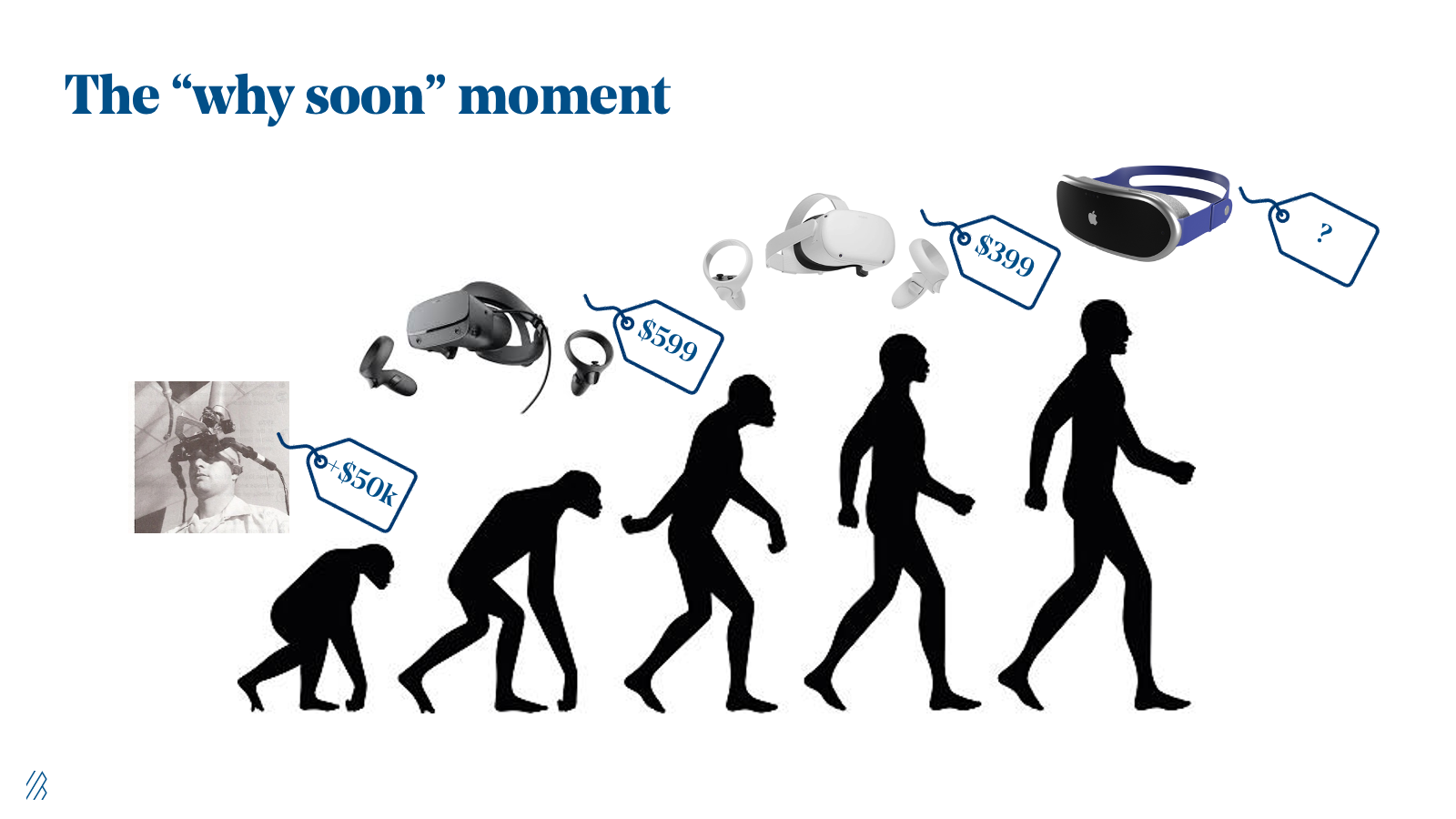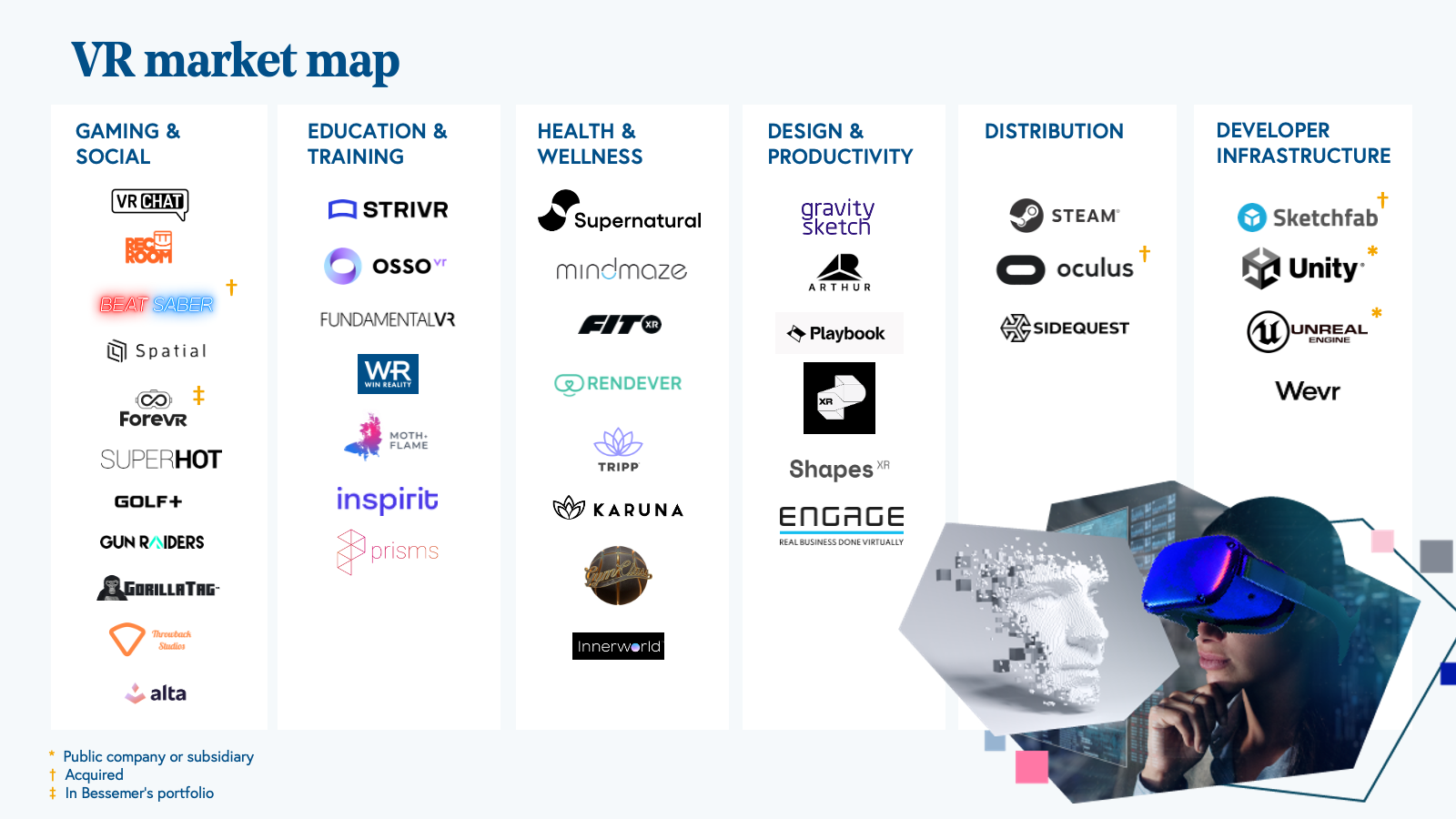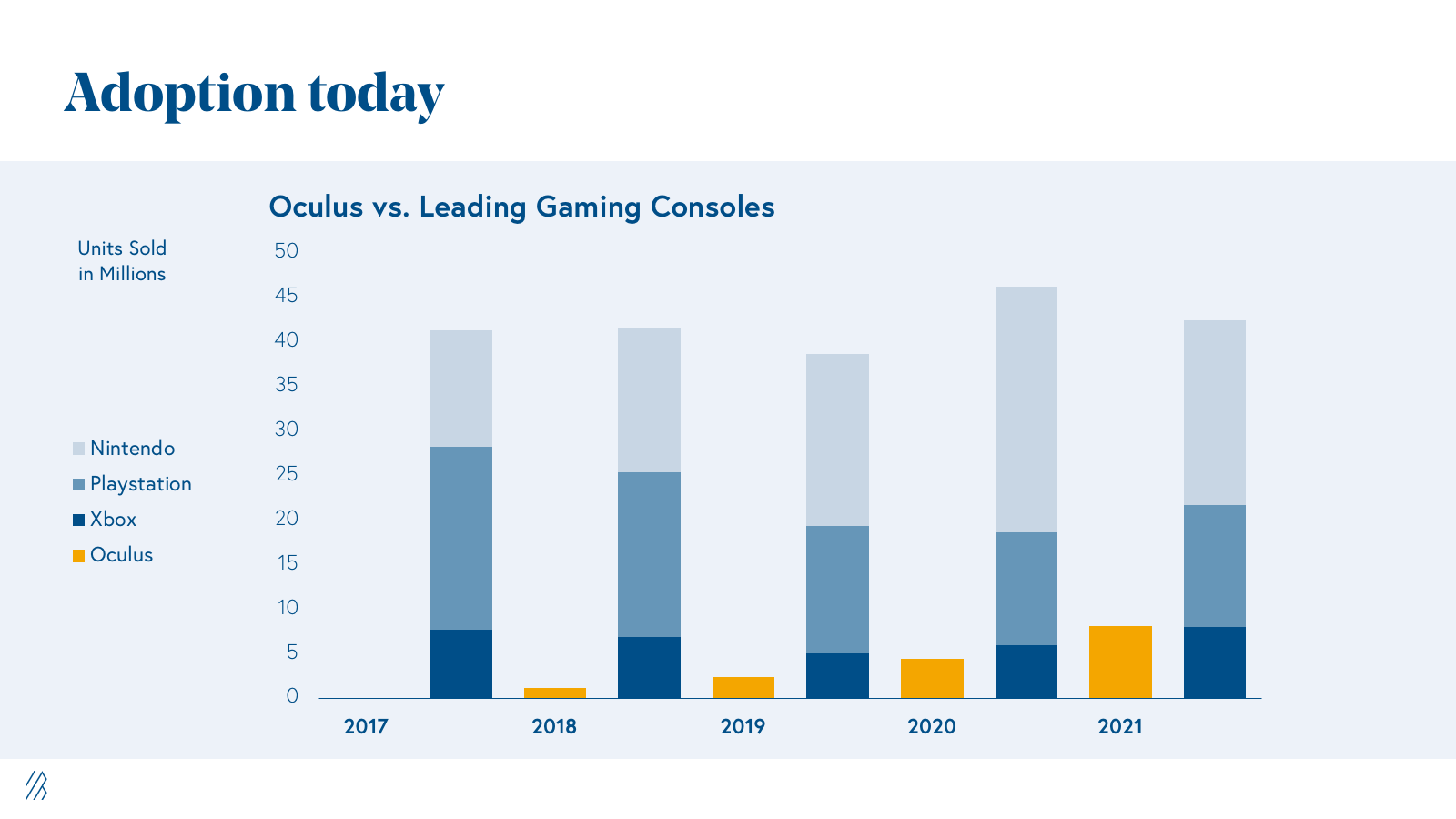Virtual reality—coming soon?
The VR revolution is not yet here, but it’s finally near—we see potential for immersive experiences and businesses from social to gaming to developer platforms.
How many times in 2015 did you hear that virtual reality (VR) would be the next big thing? Well, it is 2022 and we’re saying the same thing. Déjà vu? Inflated expectations? Maybe. But we see signs that VR is nearing an inflection point that could fundamentally change how we live, work, and play.
Thanks to years of technological advances and gradual adoption, the VR ecosystem has matured sufficiently to impact consumer behavior at scale. New platforms are often the basis for new business ideas. In the same way that personal computers, smartphones, and video game consoles laid the foundation for the last generation of multi-billion dollar consumer businesses, VR headsets and platforms hold the same potential for the next generation of consumer tech.
Why soon?
At Bessemer, we bet on the future. Rather than focusing on the “why now,” we think about the “why very soon”—the point at which platforms have evolved and pioneering technologies are reaching an inflection point in functionality, availability, and affordability. The development of the VR ecosystem is a multigenerational tale, but recent milestones indicate we are getting closer to that inflection point.
Over the last century, there have been multiple attempts to develop consumer VR headsets with only modest success until the last decade. In the 1950s, VR transformed from fantasy into reality with the Sensorama and Sword of Damocles, the first VR/AR head-mounted display. In the 1990s, Sega and Nintendo attempted to launch consumer headsets, but the products were clunky and failed to commercialize. It wasn’t until 2012, when Oculus began developing the Rift, the first major VR headset to achieve broad consumer adoption, that activity kicked into gear. The Rift was many consumers' first immersive and affordable VR experience. But its high retail price and technical limitations showed it wasn’t quite ready for mass market prime-time. When the $599 device hit the retail floor in 2016, it required a tethered connection to a powerful computer, and consumers complained about “simulator sickness.” In other words, these headsets often led to symptoms such as nausea, dizziness, and even eye strain.

A few short years later, the device has made major strides. Consumers can now buy a Meta Quest 2 for $399, 1.5x cheaper than the original flagship product. The latest headset is both cheaper and easier to use. Previously consumers had to choose between a) high-fidelity experience in a tethered headset or b) meaningfully lower quality experience with the freedom of an untethered headset. Quest is the first standalone headset that maintains high-resolution quality because its Qualcomm Snapdragon XR2 chip has double the central processing unit (CPU) and graphics processing unit (GPU) performance of its predecessor. This enabled the category to cross a key performance threshold: more powerful chips enable lower latency and higher resolution, unlocking better consumer experiences. Now consumers can have both high-res/low-latency experiences in an untethered headset.
And there are signs that the mass market wave is finally starting. Meta has sold more than 10 million headsets, quickly approaching 15 million. And Meta committed to invest at least $10 billion into Reality Labs, its division responsible for developing VR hardware, software, and content. Commercialization begets innovation. Today, developers are encouraged to create new content for the Meta Quest app store. And so the adoption-developer flywheel begins.
We’re beginning to see early indications that real businesses might be built in VR. With growth in users and revenue, companies are signaling a new application layer may be materializing, which in turn is attracting attention from venture investors and strategic buyers alike.
- Win Reality, a baseball training solution, rapidly scaled to double-digit millions of revenue in months, not years.
- Rec Room, a global gaming and chat community, remains a standalone company valued at $3.5 billion with a VR user base of 3 million MAU, growing over 3x year-over-year and only represents <10% penetration across its entire cross-platform user base.
- VRChat, a VR social platform, recently raised $80 million Series D on the back of tens of thousands of concurrent users.
- Meta acquired Beat Saber, a music game, for ~$80 million, proving strategic interest in VR businesses.
These are not the only standouts. We’ve mapped six key categories where large companies are emerging in and around VR.

Promising use cases
The most exciting VR companies check at least one of two boxes: they either a) significantly reduce the cost of a real-world alternative, and or b) deliver an experience that is impossible outside of a headset. We’ve identified a handful of promising categories with the potential to satisfy this equation, including (but not limited to) the following:
Gaming
The best gaming experiences feel real. Consumers buy huge displays and high-quality sound systems in order to feel more present in their digital worlds. Now, games like Gun Raiders offer hyper-immersive 360 game experience—some so realistic that they lead to run-ins with walls. Bessemer recently invested in ForeVR which is officially the only virtual reality app that lets you truly feel like you’re bowling on the moon!
Industrial design
Industrial design processes are often inefficient. For example, designing a car takes years of back-and-forth between design and engineering teams. These teams carve dozens of models out of clay blocks before landing on a model. Designers and engineers use Gravity Sketch to collaborate in VR and iterate on designs far faster, reducing an expensive multi-year process into a few months.
Work collaboration
We are too familiar with Zoom. It is great for some things, but it doesn’t provide a rich, immersive experience. Companies like Arthur are working on building more connected work environments in VR. From integrating with tools like Miro to enabling life-size storyboarding, digital collaboration is more engaging in VR.
Events
Watching an event on YouTube comes nowhere close to attending the real thing. VR has the potential to make the streaming experience 10x better. Companies like AmazeVR give consumers a front-row seat to high-quality immersive events. In the future, these productions will become easier to access, more realistic, and interactive.
Skills training
High-quality skills training is usually expensive and rarely convenient. Training is especially important in high-stakes fields like surgery and special operations, where real-life examples are not ideal learning grounds. Osso VR is one company enabling surgical training and assessment in VR. Not only is Osso ultimately a safer and cheaper way to train for a procedure, but it’s meaningfully better, resulting in a 230% accuracy improvement compared to traditionally-trained surgeons.
Solving challenges in VR
There are still significant challenges to building in VR today:
- Form factor: Though headsets have come a long way, they’re still uncomfortable, isolating (try checking your text messages while wearing a headset!) — and despite advances many complain of motion sickness, headaches and even injure themselves.
- Content limitations: There are fewer than 400 apps available in the Quest store today, compared to several million apps available in Apple and Android stores. This is a function of both a) the difficulty of building a high-quality VR app and b) historically limited demand.
- Nascent adoption: VR headsets still have a comparatively small user base relative to gaming consoles, and suboptimal factors like comfort and content decrease device retention. The limited user base also caps the upside potential for virality.

These obstacles have been around during every VR hype wave. So why do we think that we’re closer to solving them now?
- Hardware improvements: Thanks to Moore’s Law, we’ve seen exponential increases in computational power in the past few years. Standalone headsets today offer experiences that were fundamentally impossible five years ago. Additionally, newer headsets from Meta and Apple are rumored to be mixed reality, which will be far easier to incorporate into everyday activities. We expect this trend in improvement to continue, solving many of the form factor problems that we have in headsets today.
- Easier content development: We expect the rise of no-code building to pervade VR, even in the case of 3D engines like Unity and Unreal, which remain highly technical today. Though historically this has been hard to crack, advances in synthetic content will accelerate and democratize VR creation.
- Competition: R&D teams are investing billions into the VR hardware and software layers. Within the next few years, we’ll see dozens of headsets released by both large and small manufacturers. Each will improve on some aspect of the headsets available today (e.g. some will be cheaper, some will be higher fidelity, some far more comfortable, etc.). This competition will drive prices down and adoption up.
Three ways we think VR builders will win
We think it’s important that founders think about a few things as they build in this space:
- Find moats beyond content: 3D content will become table stakes. While the early content is exciting, it is inevitable that we’ll see copycats building look-alike products as synthetic content generation matures and 3D asset development tools improve. As the barriers to content creation drop, the best companies will have moats that imbue defensibility far beyond professional first-party content. Think: network effects, platforms, etc.
- Optimize for distribution: Because the VR install base is nascent, we’re seeing companies build cross-platform interfaces. By enabling access to their software across more platforms—for example, mobile and web in addition to VR devices—companies can expand their addressable base, reduce the initial friction of VR adoption, and build a stronger acquisition flywheel.
- Expect to launch on new platforms: We anticipate that Apple, Meta, and Google will all attempt to build their own distinct app stores. Companies should be ready to pounce on the opportunity to be early movers on each platform and not give up precious market share because they’ve locked themselves into one ecosystem.
Sectors to watch in VR 1.0
We are closely watching a few key areas:
- Social: As the barriers to adoption fall and more consumers have access to personal VR devices, the opportunities for enhanced social interaction grow. The devices can translate facial expressions, deliver immersive audio, tactile experiences, and make it feel much more “real.”
- Gaming: Compared to staring at a 2D screen while clicking a console, VR gaming is a jaw-dropping experience. We expect the most interesting opportunities to converge around social, free-to-play games that sell virtual goods and content to players. Virtual goods and character customization take on a whole new dimension in VR. When consumers buy a new piece of furniture for your virtual home or a new sword to use in a Quest, the visual effect is immediate and the feeling of ownership is real.
- Productivity: While there is a lot of potential for coworkers to engage in digital meetings, we think people that natively collaborate in 3D, such as designers and engineers, should see VR as a revolutionary productivity tool.
- Infrastructure. Underpinning all of these is the infrastructure that makes it easy to create virtual worlds—objects and environments that users can reliably interact with. We think AI is among the most promising opportunities to expedite the world creation process, but we’re also looking at companies that link together various pieces of the cross-platform development process, making it easy to generate 3D content from 2D images.
VR has the potential to scale rapidly over the coming years. The technological achievements of Meta’s Quest 2 and adoption signal that the VR flywheel is picking up speed. VR will transform the way we play games, design products, collaborate, exercise, and socialize. It is no longer an “if” question—it’s now about “when.”
If you are building in the AR/VR space, we’d love to hear from you. Feel free to reach us at virtualreality@bvp.com or on Twitter at @kentbennett, @TaliaGold, @IanRich07, @KwalkyTalky, @lucypless.






